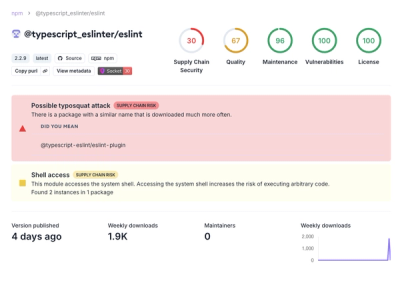
Security News
Research
Data Theft Repackaged: A Case Study in Malicious Wrapper Packages on npm
The Socket Research Team breaks down a malicious wrapper package that uses obfuscation to harvest credentials and exfiltrate sensitive data.
A gem for parsing, generating, and rendering TipTap Documents and Nodes using Ruby.
This gem is under active development and is changing somewhat quickly. There is a chance that there may be breaking changes until a stable version is released.
Install the gem and add to the application's Gemfile by executing:
$ bundle add tiptap-ruby
If bundler is not being used to manage dependencies, install the gem by executing:
$ gem install tiptap-ruby
You can parse a TipTap Document so that you can interact with it to do things such as add content (Nodes) or render it as HTML, JSON, or plain text:
document = TipTap::Document.from_json(tiptap_json)
document = TipTap::Document.new
You can also pass a block and the new Document will be yielded to the block.
TipTap::Document.new do |document|
# Do something with document
end
Now that you have a Document you can add content to it.
document.heading(level: 1) do |heading|
heading.text("My Import Document", marks: [{type: "italic"}])
end
Until the gem implements all of the node types and the documentation is complete, refer to the Document class to see the nodes that can be appended.
Once you have a Document with some content you can render it to HTML, JSON, and plain text.
document.to_h # => { type: 'doc', content: […nodes]}
document.to_html # => <div class="tiptap-document"><h1><em>My Important Document</em></h1></div>
Rendering to plain text is useful if you want to search the contents of your TipTap content.
document.to_plain_text # => My Important Document
You can extend the library to add custom node types. First, define your Node subclass.
# lib/tip_tap/nodes/gallery.rb
module TipTap
module Nodes
class Gallery < Node
self.type_name = 'gallery'
self.html_tag = :div
self.html_class_name = 'gallery'
end
end
end
Then create an initializer and define an extensions module and include it in the corresponding node. For example:
# config/initializers/tiptap.rb
require 'tip_tap'
require 'tip_tap/nodes/gallery'
module TipTap::DocumentAdditions
def gallery(&block)
raise ArgumentError, "Block required" if block.nil?
add_content(TipTap::Nodes::Gallery.new(&block))
end
end
TipTap::Document.include(TipTap::DocumentAdditions)
Now you can generate gallery nodes on a Document instance:
document = TipTap::Document.new
document.gallery do |gallery|
gallery.gallery_item(src: 'example.com')
end
After checking out the repo, run bin/setup to install dependencies. Then, run bundle exec rake spec to run the tests. You can also run bin/console for an interactive prompt that will allow you to experiment.
To install this gem onto your local machine, run bundle install.
To release a new version, update the version number in version.rb, and then run bin/release or bundle exec rake release, which will create a git tag for the version, push git commits and the created tag, and push the .gem file to rubygems.org.
Bug reports and pull requests are welcome on GitHub at https://github.com/CompanyCam/tiptap-ruby.
The gem is available as open source under the terms of the MIT License.
FAQs
Unknown package
We found that tiptap-ruby demonstrated a healthy version release cadence and project activity because the last version was released less than a year ago. It has 1 open source maintainer collaborating on the project.
Did you know?

Socket for GitHub automatically highlights issues in each pull request and monitors the health of all your open source dependencies. Discover the contents of your packages and block harmful activity before you install or update your dependencies.

Security News
Research
The Socket Research Team breaks down a malicious wrapper package that uses obfuscation to harvest credentials and exfiltrate sensitive data.

Research
Security News
Attackers used a malicious npm package typosquatting a popular ESLint plugin to steal sensitive data, execute commands, and exploit developer systems.

Security News
The Ultralytics' PyPI Package was compromised four times in one weekend through GitHub Actions cache poisoning and failure to rotate previously compromised API tokens.